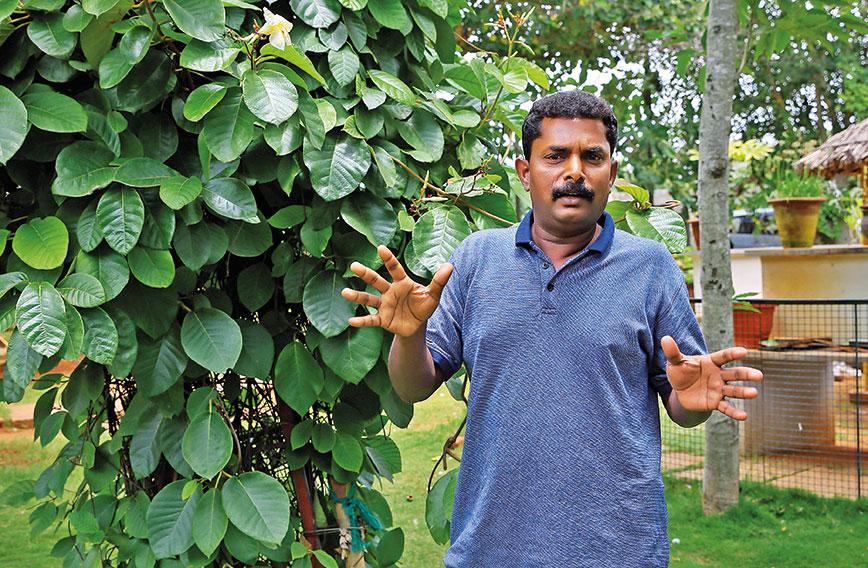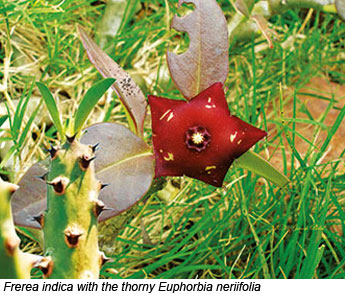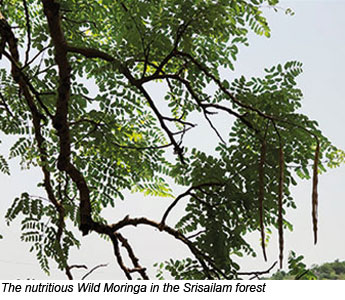
Ganesh Babu: ‘Like a child a plant needs attention and affection’
Ganesh Babu’s secret life in the wilds
Civil Society News, New Delhi/Bengaluru
IT was a plant whose reputation preceded it. An aggressive woody climber, it was known to produce small white flowers in bunches. Both attractive and imbued with medicinal properties, there were high expectations that it would be a notable performer.
But months passed and the Embelia ribes, the plant’s botanical name, showed no sign of activity. It lay dormant and didn’t bother to bestir itself even a little.
Its inert behaviour was surprising given its record as a fast and robust mover. The plant had been brought in from Kerala with the hope that it would flourish in the rambling and lush nursery of the Foundation for the Revitalization of Local Health Traditions (FRLHT) in Bengaluru.
The Embelia ribes was in fact in stellar company. The FRLHT nursery is famous for preserving and showcasing 1,500 rare medicinal plants that it has transferred from the wild. But, far from responding to its natural surroundings and inspirational neighbours, the Embelia ribes sulked in silence and didn’t seem at all impressed.
Ganesh Babu, a gifted botanist at FRLHT, tried talking to the plant, persuading it to wake up and grow. And suddenly one day a leaf appeared. Ganesh was overjoyed. It had been his sense that the plant was seeking attention. The single leaf, as he saw it, was a signal that the plant had been feeling neglected and wanted to be pampered.
Says Ganesh: “When I saw the leaf, I gathered all our gardeners and I appreciated the plant in front of them. After that appreciation, more leaves came forth.”
Ganesh decided to give the plant yet more importance: “I brought professors and spoke glowingly about the plant to them. Then I brought our director. After this, the plant began growing like anything. It means the plant knew the kind of importance and appreciation it was getting. After that it became the biggest climber in our garden.”
Sometime later, a PhD scholar at the Trans Disciplinary University, which is located on the FRLHT campus, brought 100 saplings of Embelia ribes and planted them in many places, including on the campus. Ninety-nine of the saplings died after which Ganesh was asked to save the last surviving one by talking to it.
“I think they were being sarcastic,” recalls Ganesh. “But I took up the challenge. I planted the sapling and began talking to it. It grew rapidly. It is still there as a huge climber on the last building of our campus.”
 What is it that Ganesh says to plants that makes them respond so glowingly? “Like a child, a plant needs care and appreciation. When there is no attention, the plant loses the will to live and grow,” says Ganesh. “When a plant feels, Okay, someone is there who cares for me and expects something from me, it thrives,” he explains.
What is it that Ganesh says to plants that makes them respond so glowingly? “Like a child, a plant needs care and appreciation. When there is no attention, the plant loses the will to live and grow,” says Ganesh. “When a plant feels, Okay, someone is there who cares for me and expects something from me, it thrives,” he explains.
But what are Ganesh’s conversations with plants like? “It is as I would talk to a child. I tell them, you are so beautiful, you are so purposefully here in this garden. You are invaluable and people will appreciate you for your amazing qualities. From you people will learn about our traditional medical knowledge. And you will be an example for the rest of the world to see. So you should survive, you should flourish, you should reciprocate all this love. And they do that,” he says.
Ganesh cites how he went to Madurai last year to develop the garden of Prof. D. Winfred Thomas. It was Thomas who had in fact ignited Ganesh’s interest in botany when he was at the American College in Madurai in his undergraduate years.
“They had planted Bauhinia purpurea and even after two years it was looking like a stick. It hadn’t sprouted at all. The general advice was to get rid of the plant, but Prof. Thomas asked me to talk to the plant and make it grow. I went to his garden in Madurai and talked to it and, believe me or not, within two months it started fruiting. Now it has become a tree. It all happened during the pandemic,” recounts Ganesh.
Ganesh talks to his plants in Tamil. But in which language should one talk to a plant? Does it have to be the local language? Is language at all important?
“No. The language is not important because actually language is converted into feelings and vibrations. For plants language translates into your vibrations and they respond. This is what I have experienced,” says Ganesh.
For Ganesh, attitude and intent are everything. Scholars at a government Ayurveda college in Karnataka told him they had planted seeds for a hundred Ashoka trees, but none had germinated.
| A wild plant power list CLICK HERE |
“I asked if they had talked to the seeds. They asked me what I meant. Why did they need to talk to seeds? I told them if you just put a seed into the soil without a higher intention of seeing it grow into a tree, it is the equivalent of burying the seed. But if you talk to the seed and have the expectation that it will become a tree then that is really sowing a seed which will germinate,” explains Ganesh.
“When they started talking to the seeds while sowing them, they grew into trees. Now there are 20 to 30 Ashoka trees in the Ayurveda college’s garden,” says Ganesh.
“Whether you sow a seed or bury it depends on your intent,” he explains. “When you don’t have intent the message to the seed is that it is being buried and it doesn’t bother to sprout.”
Bonding with a plant and sensing its needs is important. Plants are believed to respond to music, but once again it is the intent and the connection with the plant that matter. It makes the difference between the plant liking the music or rejecting it as noise.
Ganesh’s relationships with his plants are intuitive and subliminal. He says he instinctively knows their needs, be it water or emotional pampering.
“It is like taking care of a child,” he emphasizes time and again. “A mother doesn’t need research to tell her when her child is hungry or in need of attention.”
In India, some 6,000 plants have been identified under traditional Indian systems of medicine. Of these, the uses and actions of 2,000 have been codified in Ayurveda texts. Medicinal plants are traditionally used by communities to treat most minor disorders such as coughs and colds, fevers, breathing problems, stomach infections, digestive system imbalances, cuts, bruises and fractures.
The most trusted of Ayurvedic medicines are made from plants collected in situ and used in their entirety, which means taking all the parts of the plant together.
Traditional medicine at its original best is not reductionist. It believes in the compositeness of plant life with multiple beneficial molecules reinforcing one another as devised by nature.
| The Surgeon in Ayurveda / Darshan Shankar Speaking to Civil Society |
At FRLHT 1,500 medicinal plants have been brought from the wild and grow in its herbal garden so as to propagate their uses and ensure that they aren’t lost to overexploitation.
Since 2002, FRLHT has been promoting herbal medicine in schools and homes by providing packages of medicinal plants at low cost and encouraging people to grow them. Over time, tens of thousands of homes and schools have been reached.
“We want people to realize that medicinal plants can be both attractive and useful. These are our indigenous species. People have got accustomed to exotic plants and their flowers. We want that to change,” says Ganesh.
But not all medicinal plants can be transferred. They mostly belong to complex ecosystems in the wild that have to be replicated if they are to survive outside their habitats.
 Ganesh recalls trying to grow a medicinal plant for six months on the FRLHT campus without it responding. Then he checked out the original habitat of the plant, Decalepis hamiltonii, and found several surrounding succulent species as well as boulders.
Ganesh recalls trying to grow a medicinal plant for six months on the FRLHT campus without it responding. Then he checked out the original habitat of the plant, Decalepis hamiltonii, and found several surrounding succulent species as well as boulders.
“So, then I thought, why don't we imitate this. I brought the same kind of boulders and same type of succulent plants to our garden and within three months the plant reached 40 to 50 feet. The plant required its micro habitat conditions,” says Ganesh.
He also gives the example of Frerea indica, which is a small plant with beautiful brown flowers that grows only in Maharashtra. Ex situ the plant needs the company of thorny plants called Euphorbia nivulia and Euphorbia neriifolia and some other species from its original habitat to prosper. People tend to remove the thorny plants, thinking they will harm Frerea indica, but it is the other way around.
“There are certain plants that demand biotic associations and microclimatic conditions. They don’t grow if you don’t put in their proximity the plants they associate with in nature,” explains Ganesh.
“Not only do plants like to be talked to, they also talk to one another and cure one another. They are networked with one another. It is how the plant community lives,” says Ganesh.
“Once we remove a particular plant, the whole ecosystem gets disturbed. That is the network,” explains Ganesh emphasizing interdependence.
Ganesh travels extensively to forested areas where he is able to keep track of wild species. We spend a few days talking to him while he is at the Srisailam Tiger Reserve in Andhra Pradesh with a PhD student he has been guiding. Ganesh has been going to Srisailam off and on for 20 years.
 “There are two or three things that we do when we go to the forest,” he explains. “First, we check if there is any change in forest cover. Second, we look for new components, whether positive or negative. Third, we identify the wild beauties we can take with us and preserve.”
“There are two or three things that we do when we go to the forest,” he explains. “First, we check if there is any change in forest cover. Second, we look for new components, whether positive or negative. Third, we identify the wild beauties we can take with us and preserve.”
In the Srisailam forest there are about 2,400 known medicinal plants. Ganesh is keenly interested in the Wild Moringa which grows only there.
The moringa or drumstick is believed to be a wonder plant full of nutritional value and serving many medicinal purposes in Ayurveda. It is used to improve eyesight and for joint pains, among other things.
But the Wild Moringa is much more beneficial than the standard moringa. Tests have shown that it provides higher levels of Vitamin A.Ganesh is interested in how the Wild Moringa can be grown outside the forest and used more widely for medicinal and nutritional purposes.
As with other plants, the Wild Moringa is most effective in its entirety, which means with leaves and stalk. It could be dispensed by an Ayurvedic physician in various forms, including as a powder. But there is no substitute in traditional Ayurveda for the full plant. Of course, eating the drumstick is also hugely beneficial.
Medicinal plants come with many wondrous and unanticipated benefits — at times delivering better results than allopathic treatment, especially when it comes to systemic disorders.
Ganesh gives his own example. He used to suffer from a bleeding ulcer for many years. Since it was an extremely serious condition, he chose not to go in for Ayurveda and opted instead for allopathy.
Years of treatment and using antacids didn’t do anything to help. Then one day he decided to swallow the white pulp from the aloe vera plant. In a few days, his condition improved and soon vanished altogether.
 “I took about three inches of the aloe vera leaf. Peeled away the brown skin till I reached the white pulp beneath. I swallowed the white pulp, which is cooling and settles in the stomach,” says Ganesh.
“I took about three inches of the aloe vera leaf. Peeled away the brown skin till I reached the white pulp beneath. I swallowed the white pulp, which is cooling and settles in the stomach,” says Ganesh.
After his own experience, he has recommended aloe vera to others with gastric problems and they have all benefited greatly, he says.
Ganesh, now 47, grew up in the village of Achunthan Vayal in Ramanathapuram district, near Rameshwaram, in Tamil Nadu. He studied in the Schwartz Higher Secondary School, where Dr A.P.J. Abdul Kalam had studied some 50 years earlier.
From there, it was off to the American College in Madurai where his professors, John Jebaraj and D. Winfred Thomas, cultivated his natural interest in plants by taking him on field trips and showing him plant behaviour.
It was from them too that he learnt the importance of an ecosystem and the role that birds, butterflies and other living forms play in shaping the attributes of a plant.
“Once, when my professor was talking about a plant I eagerly told him the botanical name. But instead of being impressed he said not to worry about names so much. Instead, to first appreciate the plant, love it, enjoy its beauty and talk to it.”
Ganesh Babu the plant whisperer was born on that day and since then he hasn’t stopped seeing plants as the wondrous creations they are.
Comments
-

Debasis Ray - Aug. 3, 2022, 10:35 a.m.
Delighted to read Ganesh Babu's relationship with plants. Convinces me all the more to keep chanting my diksha-mantra when I water my plants in the morning.
-

nimesh - July 30, 2022, 11:12 a.m.
Very good article so very different and so full of knowledge, makes me plan a trip to meet Ganesh, i like most of your articles ... keep up the good writing and bringing out such Gems to the world...thank you
-

Mona S - July 30, 2022, 12:21 a.m.
Wow wow wow…. Amazing inspirations and learnings from The Plant Whisperer, Dr. NM Ganesh babu. Keep spreading such wonderful information to the world about Mother Nature. Best wishes.



